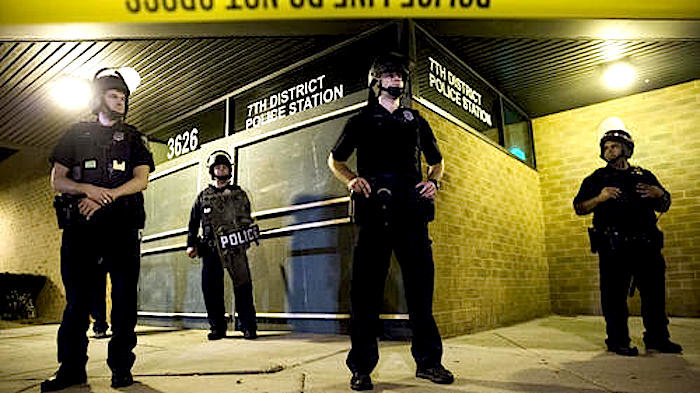"We've had a slight increase in domestic violence homicides this year, but the biggest driver of our homicides is arguments and fights and retaliation among people with criminal records," Milwaukee Police Chief Edward Flynn said Thursday. "Some of our challenge is simply consistently being able to deter armed offending through the criminal justice system," he added. "The penalties are too weak."
Comment: Penalties come after the fact. How many potential killers stop and weigh the consequences in the heat of an argument or the throes of a fight?
Although Chicago has captured national headlines for having its deadliest month in nearly two decades, Milwaukee had a higher per capita rate of killings (4 per 100,000 people) in August compared with its neighbor to the south (3.3 per 100,000 people), according to Milwaukee police.
Tracey Dent, a longtime community activist, called the statistics 'heartbreaking.'"At the same time, I have anger," he said. "I host a lot of 'Stop the Violence' events with very little support because people will say ... 'nothing's going to change.' Twenty-four homicides in one month and there's no outrage?" he continued. "That's a problem." Dent said it will take residents, police and city leaders working together to prevent and reduce deadly violence.
Flynn said he wanted to bring attention to the homicides because the killings seemed to get lost in media coverage dominated by the fatal police shooting of Sylville Smith on Aug. 13. The police shooting touched off two nights of violent unrest in the Sherman Park neighborhood. Crowds have continued to gather near the scene, N. 44th St. and W. Auer Ave., leading to recent arrests after officers were summoned to the area by nearby residents.
"The fact remains the overwhelming problem facing this city is violent crime, homicidal violent crime, that is most significant in afflicting our disadvantaged neighborhoods of color," Flynn said. "The department has been challenged by having to "expend extraordinary resources" to the continuing unrest and that "has obviously had an impact on our ability to be proactive."
City officials have said a body camera video showed Smith was armed with a gun and had turned toward the officer, Dominique Heaggan, when the shots were fired. The footage has not been released publicly to the frustration of many activists and residents, and officials do not expect to release the video until prosecutors make a charging decision.
The same weekend as the police shooting, Milwaukee experienced one of its deadliest periods of the year. Seven homicides occurred between 6 p.m. Aug. 12 and 4 p.m. Aug. 14.
During a news conference Thursday, Flynn also noted that officers continued to patrol in two-officer squads, a directive he gave after an officer was shot and wounded by a domestic violence suspect. That incident also occurred around the same time as deadly attacks on law enforcement in Baton Rouge and Dallas.
Flynn said despite those factors, officers have taken more than 1,600 guns off the streets so far this year, including 211 in August.
And so far this year, the department's homicide clearance rate is 70%, which means an arrest has been made or a suspect has been identified without the possibility of arrest (for example, a suspect may have died), according to Flynn. Clearance rates in Milwaukee have fluctuated in the past decade, reaching a high of 93% in 2008, and landed at just over 60% last year.
The city has recorded 93 homicides this year, a nearly 9% decline from the 102 victims at this time last year. The 2016 preliminary data follows FBI crime-reporting standards and does not include seven other killings that authorities ruled were self-defense or negligent or that remain under investigation. Last year, the city had 146 homicide victims, the highest total since 1993 when 160 people were killed.




Comment: Planetary unrest, countries in turmoil or war, governmental chaos, economic uncertainty, rampant inhumanity, societal unrest and dogs going mad...the trickle down effect likely hasn't hit bottom yet. More "Milwaukees" on the way, sorry to say.